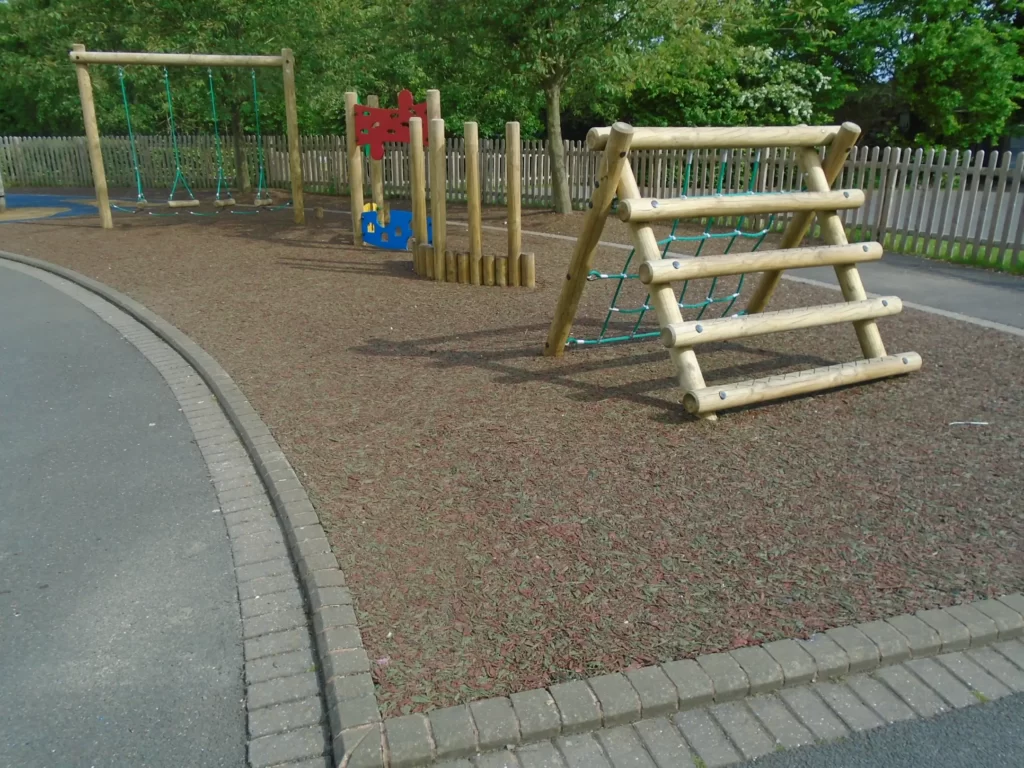
A nursery playground should be fun and safe, with physical activities to help children. These activities should develop their motor skills and help them explore the world around them.
Unfortunately, hazards in a nursery playground sometimes get in the way of all this. Therefore, knowing what they are and how to prevent or reduce their impact is essential.
Here are seven common hazards in playgrounds and how to reduce the risk.
- Falls from climbing equipment
- Trip hazards
- Cold Weather Hazards
- Inadequate supervision
- Lack of adequate shade and shelter
- Lack of Playground Safety Knowledge
- Poorly maintained equipment
1. Falls from climbing equipment
Ensuring a child never falls from a piece of climbing equipment is almost impossible.
What is possible is making sure that you are doing everything a playground owner can do to make the environment as safe as possible.
Proper safety flooring is essential to minimise any injuries that might occur as a result of a fall.
Playground flooring can become old and worn over time. Or, it might not have been suitable for the climbing equipment from the start.
Critical Fall Height (CFH) is a factor that playground installers must consider.
Simply put, the Critical Fall Height is the distance from the highest point a child can place their foot to the ground. The measurement starts from the child’s foot. There is a maximum CFH of 3 metres.
It is essential to ensure that your playground follows the guidelines outlined by the BS EN 1177 safety standards. These guidelines detail how to grade the surface based on how high a child can climb.
If you are unsure whether your nursery playground safety surface is adequate, get a free maintenance survey from our team.
2. Trip hazards
Trip hazards can occur in playgrounds due to poor design, general wear-and-tear in old, damaged flooring or even root damage to tarmac and safety surfaces.
Exposed playground edging through lost wood-chip can create a trip hazard for children. In addition, damaged soft pour or rubber mulch flooring and root-damaged tarmac are all risks that pose a trip hazard.
Protect your kids and provide them with a safe environment by avoiding these common nursery playground injuries.

3. Cold Weather Hazards
All-weather outdoor play is essential in enabling children to explore their surroundings, helping to develop their understanding of the natural environment in different seasons and helping to build resilience.
With changes in temperature during the colder months, the risk of slips, trips, and falls significantly increases due to rain, frost, snow, and ice.
Some simple ways to reduce the risk of injury during these periods without limiting play too much are as follows:
- Removing snow and gritting walkways
- Appropriate footwear and clothing
- Additional members of staff to support safety
- Areas that offer shelter
- Shortened periods of play
- First aid trained member of staff
- A dedicated first-aid kit
- Educating children on playground safety for different weather
4. Warm Weather Hazards
Without a doubt, the most significant risk factors for young children when enjoying outdoor play during the hot summer months are injuries relating to sun exposure.
The three most obvious that come to mind are:
- Sunstroke
- Sunburn
- Dehydration.
Apart from being mindful of time spent in the sun, the most effective way to deal with outdoor play in summer is using outdoor shelters such as custom wooden gazebos or playground shade sails.
Outdoor shelters can double as play spaces and outdoor learning spaces. These can help prolong play times during the hotter months.




Get a Free 3D Render
Get a Free 3D Render when you book a free site visit with our team
Book a Free Site SurveyTell me what type of Shelter is right for me
5. Inadequate supervision
Creating a pre-agreed strategy among staff members for supervising young children on outdoor play equipment can significantly help improve safety.
Some of these simple to-implement steps include:
- Rotating class access to play equipment to control playground traffic
- Appropriate child-to-adult ratio
- Focusing supervision on higher-level equipment where the risk of injury is greater
6. Lack of Playground Safety Knowledge
Educating children on playground safety at a young age is one of the best ways to help keep them safe. Here are some simple pointers to get you started on topics for playground safety education:
- Learning to take turns using the equipment.
- No roughhousing, pushing or pulling.
- Only climbing on designated climbing equipment.
- Being clear on play equipment entrances and exits.
- Becoming aware of equipment temperature changes in the summer.
7. Poorly maintained equipment
Old or poorly maintained play equipment can be dealt with efficiently by arranging regular maintenance visits.
These visits can help identify and remove risks. These include broken or damaged rails, railings, and trip and suspended hazards (entrapment or entanglement). Or even identify areas that have become unsafe with sharp or rough edges over time.
Regular maintenance can be far more cost-effective than having to replace entire pieces of equipment. You can even carry out regular risk assessments using a templated format to make those maintenance visits more effective.
Once you have invested in your outdoor playground, regular maintenance is key to keeping it in top condition.
Got concerns about your play area?
Take advantage of our free site visit to see how we can help you improve the safety of your play space.
Book a Free Site Survey